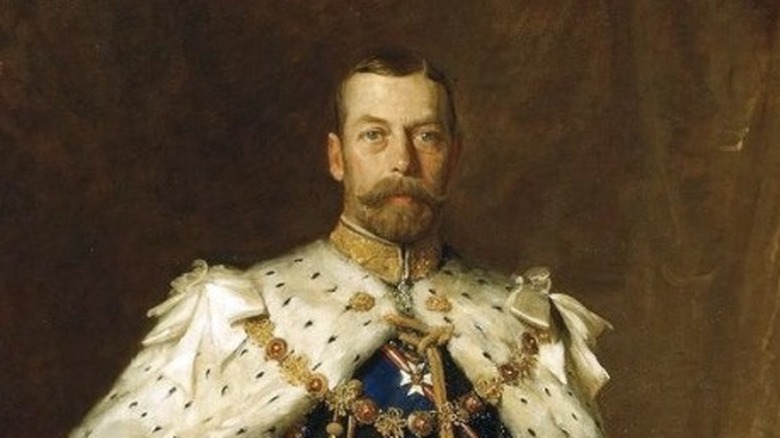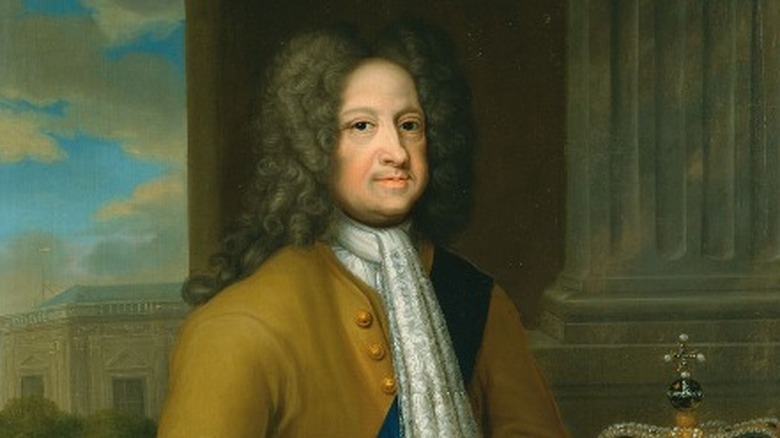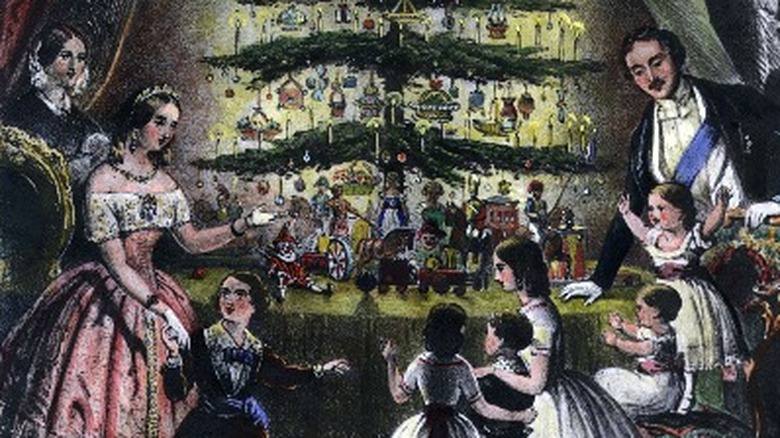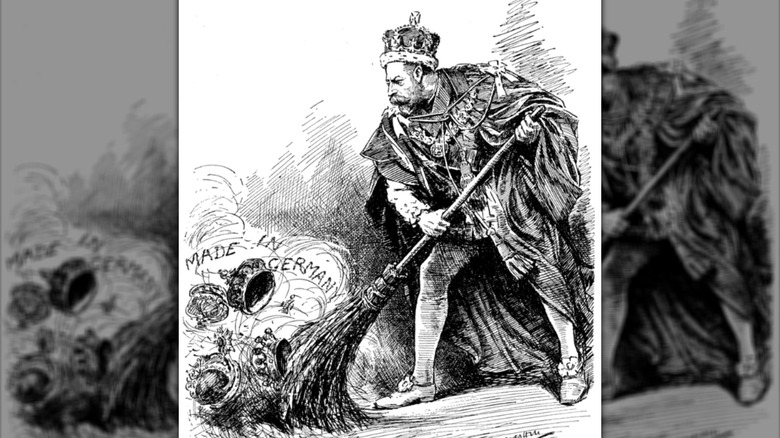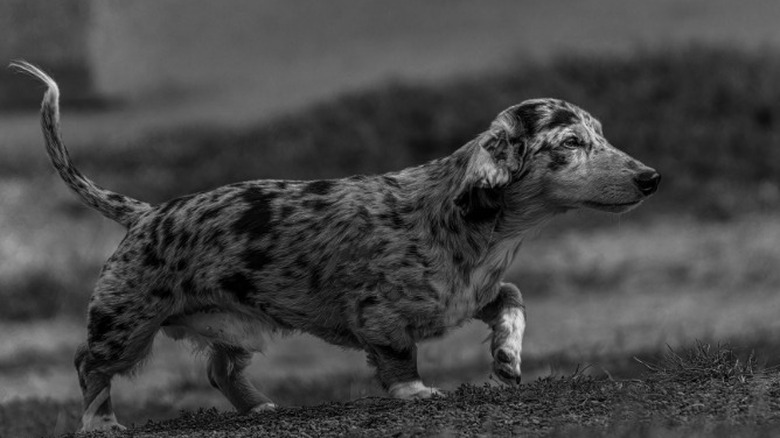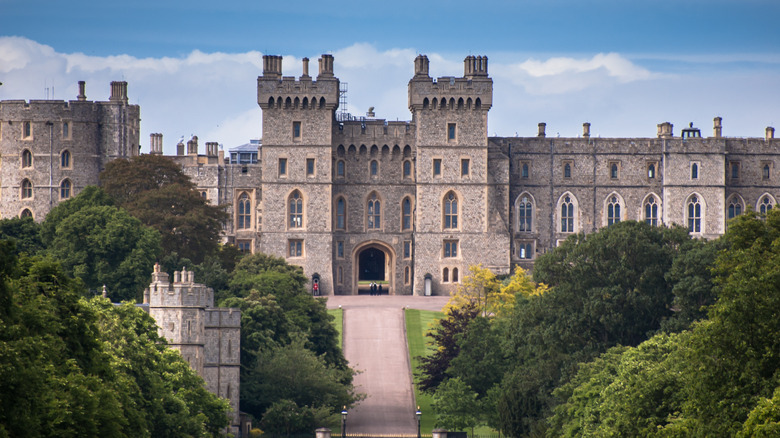The Origin Of The Windsor Royal Family Name Is Wilder Than You Think
What does the name of the British royal family have in common with sauerkraut, hamburgers, and frankfurters? They were all renamed following the outbreak of World War I to remove associations with Germany. On July 17, 1917, King George V changed the name of the U.K.'s royal line from the German Saxe-Coburg and Gotha to Windsor, the English name still used today by the late Queen Elizabeth II and her descendants, including current King Charles III, according to The Guardian. "[A]ll descendants in the male line of Queen Victoria, who are subjects of these realms, other than female descendants who marry or who have married, shall bear the name of Windsor," King George V told his Privy Council, according to the Royal Family.
When George V changed the royal family name to Windsor, he also made another change. He stipulated that Windsor would be the surname of his descendants. Before that, members of the royal family had a house name, but not a surname in the way ordinary civilians do. Queen Elizabeth II reaffirmed Windsor as the royal house name when she was crowned in 1952. However, she decided in 1960 that her children with husband Prince Philip and their line would have a slightly different last name: Mountbatten-Windsor. Mountbatten was the last name that Prince Philip, who was originally from Greece, adopted when he was made a British citizen in 1947.
A German family in England
While European nation states have been at each other's throats throughout history, their royal families have been remarkably intertwined. So it's not so strange that the past two reigning royal houses in the U.K. were actually of German extraction. The first was the House of Hanover, which came to power in 1714 with King George I, according to Britannica. Before moving to Britain and taking a British name, King George I was the elector of Hanover George Louis. He was more comfortable speaking German than English when he took the throne, according to ThoughtCo., so why was he chosen? Religion.
In 1688, England experienced the so-called Glorious Revolution, per The Royal Family. This was a bloodless power transfer in which members of parliament were worried about King James II's Roman Catholicism and belief in the divine right of kings. So they offered the throne to his Protestant daughter Mary II, and James II went into exile. The incident coincided with the passage of a Bill of Rights in 1689 that helped establish England as a constitutional monarchy. To preserve its power, and make sure that the monarchy remained in Protestant hands, parliament passed the Act of Settlement of 1701. This stipulated that the crown would go to Anne, who was a Stuart, according to Britannica. If she died without children, the crown would go to King James I's granddaughter, the Protestant electress of Hanover Sophia. Because Sophia died before Queen Anne, her son George took the throne.
From Hanover to Saxe-Coburg and Gotha
When George I was crowned, he was actually 52nd in the line of succession that included Catholics, according to The Royal Family. Both he and his son George II were seen as foreigners by many, and the Stuart heirs James Edward and Charles Edward tried to unseat them in 1715 and 1745, according to Britannica. However, George III was born in England and came to be more widely welcomed. In the end, the Hanover Dynasty lasted for six monarchs and nearly 200 years.
The last Hanoverian monarch was Queen Victoria, who ruled from 1837 to 1901. In 1840, she married the German Prince Albert, who was the son of the Duke of Saxe-Coburg and Gotha, according to The Royal Family. Albert brought more than his family name from Germany. He introduced several iconic Christmas traditions from his home country including the Christmas tree, according to ThoughtCo. An illustration of the royal family standing in front of their tree was published in the London News in 1848, and many readers decided they wanted trees of their own, according to Royal Museums Greenwich.
The problem with Gotha
The reign of the Saxe-Coburg and Gotha house name only lasted for 16 years: the nine-year reign of King Edward VII and the first seven years of King George V's reign, according to The Royal Family. By 1917, Germany was no longer associated with Christmas trees. Instead, it was linked in the British mind to the horrors of World War I, which Britain entered on August 4, 1914. Public opinion especially turned against Germany when the country began bombing London, according to The Guardian. One attack on June 13, 1917, hit the Upper North Street School in London's East End and killed 18 children. What's more, the bombers behind the raid were known in German as Gotha bombers. Little more than a month later, King George V changed the family name to Windsor.
The king was under additional pressure to distance himself from his German roots because the country's wartime leader Kaiser Wilhelm II was actually his cousin, ThoughtCo. pointed out. In addition to adopting Windsor, the king also anglicized other royal family titles, changing the Duke of Teck to the Marquis of Cambridge, Prince Alexander of Teck to the Earl of Athlone, Prince Louis of Battenberg to the Marquis of Milford Haven, and Prince Alexander of Battenberg to the Marquis of Carisbrooke, according to The Guardian.
Anti-German sentiment
The British royal family was not the only entity to see a name change because of anti-German sentiment during World War I. The practice of name-changing became especially popular across the Atlantic in the United States. Classic German foods sauerkraut, hamburgers, and frankfurters were renamed "liberty cabbage," "liberty steak," and "liberty sausage" respectively, according to Iowa Culture (via Medium). As the British royals tried to distance themselves from the German in their family tree, so too did the lovers of German dog breeds. German shepherds began to be called "Alsatian Wolf Dogs" and Dachshunds became "Liberty Pups." Even negative things had to be renamed. German measles was dubbed "liberty measles."
While all of this is fairly amusing in hindsight, it had less humorous consequences. A young man of German origin was actually hung and killed by a mob in Maryville, Missouri, when he was simply looking for a job, according to the book "Burning Beethoven: The Eradication of German Culture in the United States during World War I" by Erik Kirschbaum (via HPPR). In Scott County, Iowa, some German Americans were beaten, run out of town, or forced to kiss the flag in public, according to Iowa Culture (via Medium).
Why Windsor?
While many World War I era name changes didn't stick, the royal name Windsor did. Perhaps that's because the name seemed a natural fit for the British royal family since it had a history of its own. King George V chose the name Windsor in honor of Windsor Castle, according to ThoughtCo. Windsor Castle is both the oldest and the biggest currently occupied castle anywhere on Earth, according to Royal Collection Trust. it is also integral to English royal history, having originally been built by William the Conqueror between 1070 and 1086, according to the Royal Collection Trust. He chose a location above the Thames near an old Saxon hunting area. Since his day, more than 40 kings and queens have called it home.
When William, who was French, named the castle, he was embedding himself into English history. He named its location "New Windsor" because the previous Saxon kings had ruled from a place called Old Windsor, according to Ancient Fortresses. Like the name Windsor, it is still intimately associated with the British royal family. The late Queen Elizabeth II spent weekends there and used it as a staging ground for official royal duties, according to The Royal Family. She was also buried in the royal vault at Windsor's St. George's Chapel, The New York Times reported.
